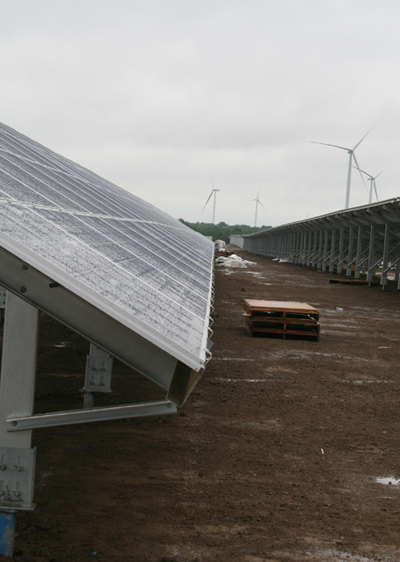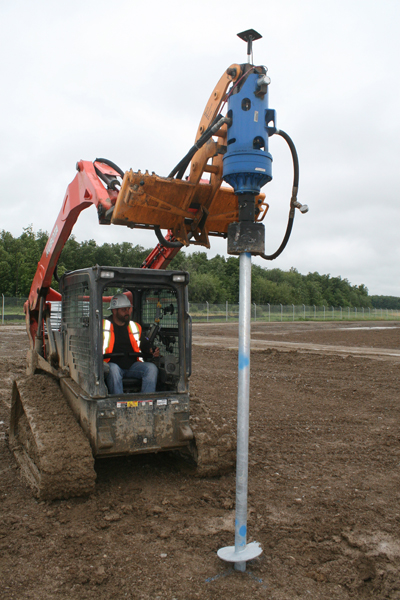GPS Tracking Speeding Installation: At Canada's largest solar farm
 At a solar power project in Cayuga, Ontario, a fleet of skid steer loaders—each equipped with a GPS—is quickly and accurately drilling the more than 100,000 piles that are required. These piles, a significant project component, are needed to support the nearly half-million solar panels at what’s shaping up to be the largest solar farm in all of Canada. That global navigation satellite system (GNSS)-equipped fleet is helping the general contractor dramatically rewrite the book on solar farm construction. Help from above? In a solar project, it seems only fitting.
At a solar power project in Cayuga, Ontario, a fleet of skid steer loaders—each equipped with a GPS—is quickly and accurately drilling the more than 100,000 piles that are required. These piles, a significant project component, are needed to support the nearly half-million solar panels at what’s shaping up to be the largest solar farm in all of Canada. That global navigation satellite system (GNSS)-equipped fleet is helping the general contractor dramatically rewrite the book on solar farm construction. Help from above? In a solar project, it seems only fitting.
A grand project
Located about 30 miles south of Hamilton, Ontario, the Grand Renewable Solar Project, covers nearly 800 acres of former farmland, and sits amidst a sea of wind turbines—a part of Samsung’s Grand Renewable wind power development in that area.
According to representatives from the construction firm heading up the project, it became evident early on in the planning phase that traditional methods for laying out and setting the piles, which support each of the solar panel tables, wouldn’t suffice. The sheer scale of the undertaking (more than 100,000 piles need to be drilled with extremely tight tolerances) means alternative approaches had to be examined.
It was soon decided that the entire process could be enhanced by employing global positioning systems (GPS) in the drilling facet of the operation, and before long a fleet of skid steer loaders were outfitted with these tracking devices. It was a move that would reshape the way work would be done at the Cayuga site—and, likely, in similar renewable projects in the future.
Project ready
It’s important to note the overall complexity of the Grand Renewable project, and the creative ways in which those challenges have been addressed. To make the site ready for panel installation, a considerable amount of cut-and-fill work had to be performed, resulting in varied soil conditions throughout the jobsite. Consequently, soil bores were taken and, based on the results of those samplings, a pile was designed to meet the load requirements and fit the ground conditions. Now the company has several lengths of piles that are color-coded, based on the pile elevation after installation.
With those color codes assigned, a survey crew is spotting the locations for each piling and marking the ground appropriately. A pile deployment crew, then, goes out and stages piles according to that color. With markers in place, work commences with one worker raising the pile into position and the skid-steer operator drilling it.
It’s at this point that the skid-steer-mounted GPS units installed prove their value. Without the GPS, construction crews would have to set offset points to monitor the piles’ “X” and “Y” positions, and either string line or pipe laser the elevations (a slow and laborious process with far too great a risk of inaccuracy).
Although the manual survey would give the construction company the pile’s location, relative to east and west, it’s the ability to nail the elevation to within 1.5 centimeters that’s proving invaluable.
The tables at the site are far from flat; they rise and fall, they have break points, each row is sloped for drainage. In some areas, there can be as much as a two-meter difference between the top end of the field and the bottom. The combination of the GPS accuracy, an onboard torque monitoring system, and advanced logistics is allowing the project to reach production levels never before imagined. With seven machines, crews are capable of installing anywhere from 1,100 and 1,200 piles per day—a production rate that’s unheard of in this business.
A new approach
 The construction firm’s embrace of tracking technology has gone beyond basic panel installation. The massive amount of site work needed for the solar panels themselves, as well as for the infrastructure required to support them, was made significantly faster and easier with the help of seven, full, GPS 3D machine control systems. These systems were installed on a range of dozers, excavators, and scrapers.
The construction firm’s embrace of tracking technology has gone beyond basic panel installation. The massive amount of site work needed for the solar panels themselves, as well as for the infrastructure required to support them, was made significantly faster and easier with the help of seven, full, GPS 3D machine control systems. These systems were installed on a range of dozers, excavators, and scrapers.
The company’s skid-steer operators are able to monitor progress of each pile’s position during installation via a screen-driven controller mounted in the cab. In addition to ensuring position and overall elevation accuracy, the machines are equipped with an equally valuable torque monitoring system.
Because of the varied nature of the soil throughout the project site (and to verify when undisturbed soil below has been reached), the monitoring systems record torque every three seconds for the last 1.1 meters of every pile drilled. That data is, then, used to compile reports for the project owner’s engineers.
So far, this new approach has paid off nicely. Failure rates—the times when a pile has to be removed, the area excavated, re-compacted, and the pile reinstalled—are down under the one percent range, when operators don’t meet an obstruction during installation.
Beyond the shadows
Upon installation of a set of pilings, a quality control team surveys and verifies each piling that’s been drilled. This level of accuracy is necessary to ensure the racking is aligned and squared for the solar panels to sit properly. Aside from casting a shadow on an adjacent panel, improper alignment can also result in the problem being compounded down a line of panels, which can stretch for hundreds of meters.
The Grand Renewable Solar Project started with just four skid-steers, but a 10th and an 11th unit has now been added—proof of how much of an impact satellite tracking and monitoring can have on solar installations.
It’s expected that the pile-drilling portion of the project, which reportedly represents enough steel to construct two Eiffel Towers, will be completed in October or November 2014—thanks to the speed and accuracy of drilling some 800 piles per day, which is now considered an average day at Grand Renewable Solar.
Anthony White is GPS and survey coordinator for Bondfield Construction Company, Ltd.
Additional article information provided by Scott Frechette, Bondfield’s drilling superintendent.
Bondfield Construction Company, Ltd.
www.bondfield.com
Topcon Positioning Systems
www.topconpositioning.com
Author: Anthony White
Volume: November/December 2014









.gif?r=5481)

.jpg?r=7333)
.jpg?r=1416)